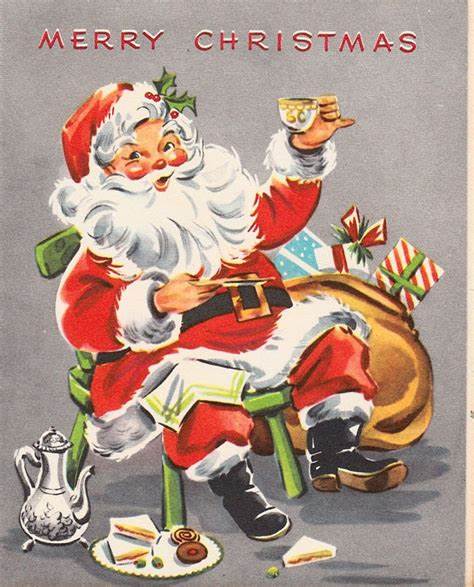Should Santa Claus be allowed at Lake Land?

This 1950’s Christmas card depicts the modernized jolly Santa Claus eating cookies. Photo via Pinterest
December 1, 2021
Lake Land College’s (LLC) Student Activity Board planned a Dec. event in which Santa would be handing out cookies and taking pictures with students. However, the Advisory Board cancelled the event because they were afraid that Santa would be offensive to some students due to Santa’s religious background. They said that Santa was a Christian figure and should not be allowed at a public College.
The tale of Santa Claus originated from a Turkish Monk named St. Nicholas. It is said that St. Nicholas gave away all his money and traveled throughout the country helping the poor and sick. He also saved three sisters from being sold into slavery and prositution by providing them with a dowry so that they could be married instead. By the Renaissance era he became the most popular Saint in Europe. By the end of the 18th century, St. Nicholas became a popular character in American Culture. Americans began to celebrate his death anniversary which was on Dec. 6. St. Nicholas became associated with Christmas due to his caring nature, gift giving and his death celebration being so close to Christmas. The name “Santa Claus” originated from his Dutch nickname ‘”Sinter Klaas.” By 1820, stores began to advertise Christmas shopping and often featured Santa. Christmas quickly became centered around gift giving mainly focused towards children. In 1890, the Salvation Army decided to have unemployed men dress up as Santa and take donations on the streets of New York. These donations went towards paying for free Christmas meals for those in need. The Salvation Army Santas have continued this tradition every holiday season and have expanded all over America. The Macy’s Thanksgiving Day Parade gained a lot of popularity to Santa after they started featuring him in 1924. Children began to line up to meet Santa in New York’s Macy stores. Children’s obsession over Santa was noticed by malls all over the Country and Santa started to appear in nearly all malls around the holiday season.
The origin of Santa Claus has little to do with Christianity or religion at all. Santa is a symbol of gift giving and helping others around the holiday season. Corrina Hernandez, a freshman at Lake Land College also believes that Santa is simply a symbol of Christmas and not of Christianity. She stated that, “I believe Santa is a modern symbol to represent Christmas and help get kids and families into that Christmas spirit and he is obviously a huge part of Christmas. But personally I do not believe he is a Christian entity. When it comes down to the true meaning of Christmas, the birth of Jesus, mangers and nativity scenes are used to represent Christianity.”
Santa Claus handing out cookies and taking pictures at Lake Land College would not be a religious event. It would be an event full of holiday spirit and would give students a chance to take a break from classes while hanging out with Santa and friends, and eating some Christmas cookies. Santa is a big part of Christmas and should not be seen as a religious figure. St. Nicholas’s history should have been considered when Lake Land College decided to cancel this event. Santa originated from a place of kindness and should remain in this same light.


